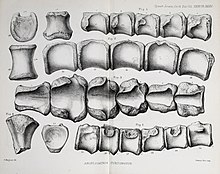Anoplosaurus
| Anoplosaurus Temporal range: late Albian, | |
|---|---|
 | |
| Holotype vertebrae of A. curtonotus | |
| Scientific classification | |
| Domain: | Eukaryota |
| Kingdom: | Animalia |
| Phylum: | Chordata |
| Clade: | Dinosauria |
| Clade: | †Ornithischia |
| Clade: | †Thyreophora |
| Clade: | †Ankylosauria |
| Clade: | †Euankylosauria |
| Family: | †Nodosauridae |
| Genus: | †Anoplosaurus |
| Type species | |
| †Anoplosaurus curtonotus | |
Anoplosaurus (meaning "unarmored or unarmed lizard") is an extinct genus of herbivorous nodosaurid dinosaur, from the late Albian-age Lower Cretaceous Cambridge Greensand of Cambridgeshire, England. It has in the past been classified with either the armored dinosaurs or the ornithopods, but current thought has been in agreement with the "armored dinosaur" interpretation, placing it in the Ankylosauria.
History
[edit]Harry Govier Seeley named this genus in 1879 for a disarticulated partial postcranial skeleton that had been uncovered no later than 1878 at Reach, Cambridgeshire, composed of a left dentary fragment, numerous vertebrae from the neck, back, and sacrum, parts of the pectoral girdle, humerus fragments, part of the left femur, left tibia, foot bones, ribs, and other fragments. He regarded it as possibly juvenile, due to its small size,[1] with a length of about five feet. The type species is Anoplosaurus curtonotus. The generic name, derived from the Greek hoplo~, a word element used in combinations, with the meaning of "armed", refers to the fact no armour plates had been discovered. The specific name is derived from Latin curtus, "short", and Greek νῶτον, noton, "back".
A second species, Anoplosaurus major, "the larger one", was named by Seeley in 1879 for a neck vertebra and three partial caudal vertebrae he removed from the material previously referred to Acanthopholis stereocercus, from the same formation as the type species.[1] This species now appears to be chimeric, the neck vertebra coming from an ankylosaur, the caudals from an indeterminate iguanodont.[2][3][4]
Although Seeley assigned Anoplosaurus to a general Dinosauria, he understood its possible affinities with Scelidosaurus or Polacanthus, as shown by the genus name, and other workers began to see it as an armored dinosaur.[5][6] In 1902, Baron Franz Nopcsa referred both species to Acanthopholis, creating a Acanthopholis curtonotus and a Acanthopholis major.[7] In 1923 Nopcsa suggested that, while some of the remains belonged to Acanthopholis, other remains, which he removed from that genus, belonged to a camptosaurid.[8] This suggestion led to considerable confusion, with some authors beginning to classify Anoplosaurus under the Camptosauridae,[9] a practice that was continued over several decades (with modifications as iguanodontian taxonomy changed over the years).[10]
In 1964, Oskar Kuhn renamed Syngonosaurus macrocercus Seeley 1879 into Anoplosaurus macrocercus. In 1969, Rodney Steel renamed Eucercosaurus tanyspondylus Seeley 1879 into Anoplosaurus tanyspondylus. Both Syngonosaurus and Eucercosaurus are today seen as nomina dubia and these last two Anoplosaurus species are hereby equally invalid.[2]
In 1998, Xabier Pereda-Suberbiola and Paul Barrett reexamined the material of Anoplosaurus curtonotus. They wrote that it all belonged to a "primitive" or basal member of the Nodosauridae, the lack of armor possibly due to the young age of the animal at death. The basal position would be indicated by the long tooth row and the low sacral vertebrae count. Seeley had never indicated a holotype among the syntype series. Pereda-Superbiola & Barrett therefore selected specimen SMC B55731, a right scapula piece, as the lectotype. Its ankylosaurian affinities would be proven by a high acromion process. The other nodosaurid fossils found at Reach, specimens SMC B55670 - 55742, were assigned as paralectotypes. Pereda-Superbiola & Barrett considered it possible that the discovery had in fact not been made in the Cambridge Green Sand but in the, also Albian, Upper Gault Clay, because the skeletal elements seemed to have belonged to a single individual which might preclude a provenance from the very reworked marine Green Sand deposits. Anoplosaurus curtonotus was by them considered a possibly valid taxon.[2] Reviews since then have followed this interpretation of the genus as an armored dinosaur belonging to the Ankylosauria.[11][3]
Palaeobiology
[edit]As a possible nodosaurid, Anoplosaurus would have been a quadrupedal, low-slung herbivore, with armour on its body for protection.[3]
See also
[edit]References
[edit]- ^ a b Seeley, H. G. (1879). "On the Dinosauria of the Cambridge Greensand". Quarterly Journal of the Geological Society. 35 (1–4): 591–635. doi:10.1144/GSL.JGS.1879.035.01-04.42. S2CID 129277596.
- ^ a b c Pereda-Suberbiola, X.; Barrett, P.M. (1999). "A systematic review of ankylosaurian dinosaur remains from the Albian of England" (PDF). Special Papers in Palaeontology. 60: 177–208. ISBN 978-0-901702-67-8.
- ^ a b c Vickaryous, M.K., Maryańska, T., and Weishampel, D.B., (2004). Ankylosauria. In: Weishampel, D.B., Dodson, P., and Osmólska, H. (eds.). The Dinosauria (second edition). University of California Press:Berkeley 363-392. ISBN 0-520-24209-2
- ^ Norman, D.B. 2004. Basal Iguanodontia. In: Weishampel, D.B., Dodson, P., and Osmólska, H. (eds.). The Dinosauria (second edition). University of California Press:Berkeley, 413-437. ISBN 0-520-24209-2.
- ^ Zittel, K.A. (1893). Traité de Paléontologie III, Paléozoologie, Vertebrata (Pisces, Amphibia, Reptilia, Aves). Paris:Doin, xii-894. [French]
- ^ Hennig, E. (1915). Kentrosaurus aethiopicus. Die Stegosaurier-Funde von Tendaguru Deutsch-Ostravrika. II. Historisch-systematische Einführung. Palaeontographica Supplement 7: 103-253. [German]
- ^ F. Nopcsa, 1902, "Notizen über cretacische Dinosaurier", Sitzungsberichte der Mathematisch-Naturwissenschaftlichen Classe der Kaiserlichen Akademie der Wissenschaften 111(1): 93-114
- ^ Nopcsa, Baron Francis (1923). "Notes on the British dinosaurs, Part IV: Acanthopholis". Geological Magazine. 60 (5): 193–199. doi:10.1017/S0016756800085563.
- ^ E. Stromer, 1934, "Ergebnisse der Forschungsreisen Prof. E. Stromers in den Wüsten Ägyptens. II. Wirbeltierreste der Baharîje-Stufe (unterstes Cenoman). 13. Dinosauria", Abhandlungen der Bayerischen Akademie der Wissenschaften Mathematisch-naturwissenschaftliche Abteilung, Neue Folge 22: 1-79
- ^ Norman, D.B., and Weishampel, D.B. (1990). Iguanodontidae and related ornithopods. In: Weishampel, D.B., Dodson, P., and Osmólska, H. (eds.). The Dinosauria. University of California Press:Berkeley, 510-533. ISBN 0-520-06727-4.
- ^ Carpenter, K. (2001). Phylogenetic analysis of the Ankylosauria. In: Carpenter, K. (ed.). The Armored Dinosaurs. Indiana University Press:Bloomington 455-483. ISBN 0-253-33964-2


 French
French Deutsch
Deutsch